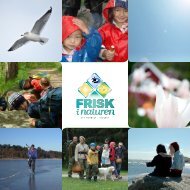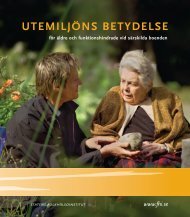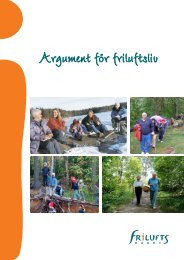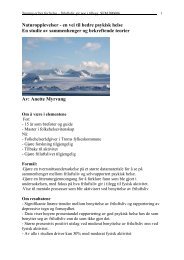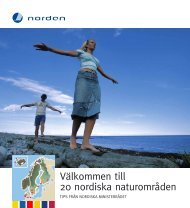Green Care: A Conceptual Framework - Frisk i naturen
Green Care: A Conceptual Framework - Frisk i naturen
Green Care: A Conceptual Framework - Frisk i naturen
You also want an ePaper? Increase the reach of your titles
YUMPU automatically turns print PDFs into web optimized ePapers that Google loves.
5<br />
<strong>Green</strong> care and its links with other<br />
interventions and approaches<br />
This section explores the similarities and links between green care,<br />
occupational therapy and therapeutic communities as psychosocial<br />
approaches to promote health and well-being.<br />
5.1 Occupational therapy and green care<br />
Occupational therapy is based on an assumption that a pleasant and an<br />
appropriate occupation can promote health and well-being. According<br />
to Kielhofner (2002), human beings share an innate occupational nature.<br />
Human occupation “refers to the doing of work, play, or activities of<br />
daily living within a temporal, physical, and sociocultural context that<br />
characterizes much of human life (p. 1).” It is an interesting notion that<br />
time becomes actually evident by doing, temporal cycles mark daily living.<br />
<strong>Green</strong> care is full of activities that have to be done in time and often at set<br />
times, such as the feeding of cattle, so green care interventions can be used<br />
to structure the stream of time.<br />
The main goal in occupational therapy is to help patients to live satisfying<br />
and productive lives when their occupational performance or participation<br />
is restricted by providing the means to manage and to adapt to the new<br />
situation. A person’s daily occupation can be limited as a result of health<br />
problems, a poorly designed environment, or problems in their social<br />
life (Christiansen et al, 2005). The affordances and restrictions of an<br />
environment define the occupational performance, which in turn modify<br />
one’s self-concept and social identity. Individuals both adapt to their<br />
environment and try to change it according to their personal objectives.<br />
Personally meaningful activities motivate and promote the development of<br />
physical and social skills which in turn leads to feelings of capability and<br />
competence. In occupational therapy the patient’s engagement is essential<br />
for successful outcomes (Holvikivi, 1995).<br />
Through occupational performance individuals are connected to roles<br />
and their socio-cultural context. There are several models connecting<br />
person, environment, occupation, and performance, for example, the<br />
person-environment-occupation-performance model (PEOP) proposed by<br />
53



